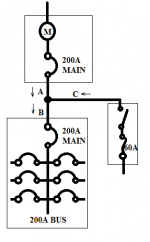Hey everyone, I have a question regarding the title code and am looking for input
Lets say a home has a 200amp meter/main, with 200 amp bus, with no branch circuit breakers in it and feed thru lugs to a secondary 200amp main breaker panel. and in this sub panel are taps before the 200 amp that go to a 60 amp fused PV disconnect. Would this be considered code compliant, or would the sum of the 200 amp sub panel breaker(load) and the 60 amp PV fuses(supply) be taken into consideration and that it exceeds the 200 amp bus rating of the main?
Thanks
What you are describing, is a feeder interconnection, rather than a busbar interconnection. I've sketched the sequence of equipment below. Currents A, B, and C are the currents that are in question. I've marked an arrow on each, indicating assignment of positive values to each one. From Kirchhoff's current law, you can see that Ib = Ia + Ic. You can also see that both Ia and Ib are limited to not exceed 200A, due to them both flowing through a 200A breaker on their side of the tap point. Ic is of course limited to 60A, and is based on inverter(s) with a current that adds up to a maximum of 48A.

Because we have a 200A main on the panelboard, the panelboard cannot draw more than 200A without tripping this breaker. The panelboard bus is protected regardless of what mixture of Ia and Ic supply current to it. Protecting the busbar is "out of the picture" of your interconnection method. The section of conductor for current C would be treated as a 240.21(B) feeder tap. The section of conductor for currents A and B, would be the feeder, and would be able to remain sized according to the rules that govern its sizing, if the interconnection weren't there.
I'd consider the conductor carrying current C as a feeder tap, though there are people who will disagree with calling it a tap by strict definition. The same working principles of conductor protection that would apply to a feeder tap with a load, would also apply feeder tap with a source. It is a conductor that is protected in excess of its ampacity, and relies on a downstream OCPD to protect it from overload.
If instead of an MCB in the panelboard, you had an MLO (main lug only), then you'd need to introduce a new 200A OCPD in some form or another between the feeder tap point and the panelboard. When you have an MLO panel fed from an externalized OCPD like a main breaker in a meter socket, that extermal OCPD acts as if it were the main breaker of your panelboard, for purposes of satisfying 705 rules on busbar protection.
Had you connected at the opposite end of the bus, rather than at a feeder tap prior to the panelboard, then this would be a situation where the 120% rule would have to be applied, and you'd actually have to consider the 200A busbar rating. If you had desired to connect a 40A system instead of a 60A system, that is where I'd recommend making your connection instead. Given a 60A system, it is reasonable to connect on that feeder tap.


